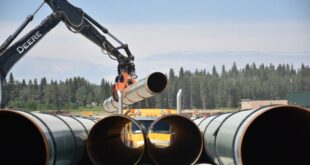After decades of declining membership, unions seem to be having a moment

After decades of declining membership, unions seem to be having a moment in North America.
Over the decades, the number of Canadian workers who belong to unions has shrunk. In 1981, 38 per cent of workers in the country were unionized, according to a recent study by the Angus Reid Institute. Last year, just 29 per cent of Canadian workers belonged to a union.
"Strikes have been virtually non-existent for most of the past 30 years or so," said Barry Eidlin, a labour expert who studies social movements at McGill University. "Those more collective solutions to people's problems at work just haven't been as much on the agenda."
But from the Canadian federal workers strike to actors and writers in Hollywood to port workers in B.C. — not to mention broadcasters at TV Ontario, city workers in Saint John, N.B., and employees at Manitoba Liquor and Lotteries — it's no wonder this has been dubbed the "summerofstrikes".
Experts say unions are being more aggressive at a time when their popular support is high.
"Two big breakthroughs in recent years were the election of new leadership in the Teamsters Union, which is one of the largest unions in North America," said Eidlin. "And then more recently, earlier this year, the election of reformers in the United Auto Workers Union."
A hard line
Shawn Fain, president of the United Auto Workers, has taken a hard line in negotiations with the big three auto companies: Ford, General Motors and Stellantis, which owns Jeep and Chrysler.
Fain has been outspoken about his union's demands, advocating for a 40-per-cent increase in wages, a four-day work week while getting paid for five, better retiree benefits and more.
"There has been an unprecedented amount of transparency at the direction of the new leadership within the UAW," said Harley Shaiken, a labour economist at Berkeley University.
"The new leadership has been very combative in terms of how they presented their demands to the Detroit automakers, but they're not manufacturing this discontent — they're channeling it."
They're holding rotating strikes, where workers go on strike at different plants at different times. It's a rarely used tactic designed to inflict chaos on the companies while allowing the union to extend the strike as long as necessary.
WATCH | The UAW refuses to say which auto plants will strike next. Why? | About That:

The UAW refuses to say which auto plants will strike next. Why? | About That
The union representing nearly 150,000 autoworkers is on strike against GM, Stellantis and Ford. Andrew Chang breaks down the impact of using rotating strikes and what the UAW is asking for from the automakers.
"This is going to turbocharge the power of the UAW bargainers by keeping the company off balance," said Shaiken.
Fain's approach comes as the perception of unions in North America remains strong and the number of labour actions is on the rise.
There have been almost 500 work stoppages across Canada since 2021, according to Statistics Canada. As a result, there have been more than five million lost workdays — the most in a three-year period since 2003 to 2005.
Two-thirds of Americans approve of unions, poll suggests
In the U.S., a Gallup poll last month suggested the approval rating for labour unions was at 67 per cent. And although that's down a few percentage points from the year before at 71 per cent (the highest it had been since 1965), it's still above the long-term average of 62 per cent.
A lot of that has to do with what they're fighting for, said Eidlin.
Eidlin points to inflation, pay stagnation, rising inequality, erosion of benefits, too many hours or too few, eroding job security, and the looming concern of automation or technological change, such as artificial intelligence, as reasons for the rise in labour movements.
"These are all trends that have been affecting Canadian workers for decades now," he said.
Add in a tight labour market and the conditions are ripe for strike activity, said Eidlin – a shift from the last few decades.
"They're fighting for issues that affect broad swaths of the population," he said.
For example, the Hollywood writers want rules around how artificial intelligence can be used to write or rewrite scripts. The outcome of that negotiation could have implications for other industries.
"If they're talking about wage stagnation, if they're talking about how to deal with technology, if they're talking about how to deal with unpredictable schedules," he said. "These are issues that resonate broadly with Canadians, Americans, with workers in general, because these are issues that a lot of them have faced."
Eidlin says that's different from the way unions have been perceived in the past.
"The shift from like, 'Why should they get that?' To, 'Oh, they're fighting for that. I want that too.' Right? There's a very, very big shift in the public mindset there," he said.
*****
Credit belongs to : www.cbc.ca
 MaharlikaNews | Canada Leading Online Filipino Newspaper Portal The No. 1 most engaged information website for Filipino – Canadian in Canada. MaharlikaNews.com received almost a quarter a million visitors in 2020.
MaharlikaNews | Canada Leading Online Filipino Newspaper Portal The No. 1 most engaged information website for Filipino – Canadian in Canada. MaharlikaNews.com received almost a quarter a million visitors in 2020.







